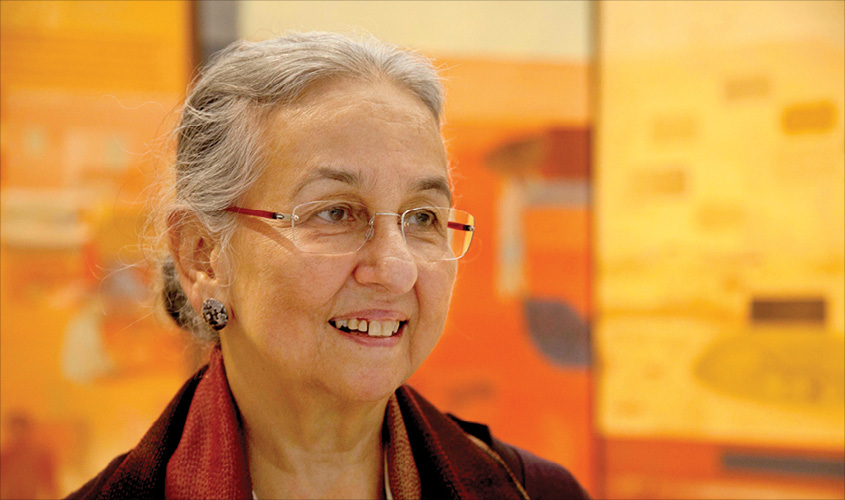After a successful opening last year at Germany’s biggest art show Documenta, Nilima Sheikh’s solo exhibition has travelled to Delhi’s Bikaner House. The show features her tempera paintings that are displayed on wooden panels, writes Bhumika Popli.
In Terrain: Carrying Across, Leaving Behind, Nilima Sheikh’s latest solo exhibition on view at Delhi’s Bikaner House, you don’t find paintings hanging on the wall. Rather, we are greeted by a series of eight rectangular wooden panels, seven-foot tall, standing side-by-side in a semi-circular arrangement.
A total of 16 tempera paintings are attached to this structure, eight on either side. These paintings were first showcased, in a similar arrangement, by the artist at Documenta in Kassel, Germany, in 2017.
Art Historian Gayatri Sinha aptly describes Sheikh’s paintings, and the way they are displayed, in her catalogue essay thus: “In the womb-like space of the structure, which also alternates as exposed, only partially revealed ellipse, is an highly emotive field, of epic love, and violence, but to render these as manifest we see Sheikh’s realisation of language of a timeless beauty, and the aesthetic challenge of allowing a theme to unfold through a discontinuous fractured narrative. Believed to trace to Indian painting of the 4th century, the Indian hand scroll has had a fuller realisation in Chinese and Japanese painting. Unlike the folding screen or the hand scroll, Sheikh renders each panel discrete.”
This style of arrangement is not new to Sheikh. Having a background in theatre design—she has created the sets of such plays as Umrao in 1993, and Sundari: An Actor Prepares in 1998 among others. So her exhibitions are always given a dramatic, unusual and stage-like setup, in which the artworks serve as props.
“My larger works are not always against the wall,” says Sheikh while speaking to Guardian 20. “Once, in an exhibition, I had placed the artworks all across the gallery, which allowed visitors to walk around them. I called the placement shamiana.”

In the present show, where the artist has once again experimented with the idea of space, she has hung these 7ft-by-3ft paintings on large wooden panels. Each painting narrates a different story, of a socio-political nature. Displacement is the primary theme the artist is dealing with. One artwork, entitled Family, interweaves the scenes from city and village life. It represents a series of domestic tableaus: a female figure sweeps the floor; while another one cooks alongside a toddler; a male figure lays on a bed; two men in a landscape.
In the same artwork, we see a man holding a sword to behead a woman, while another woman watches helplessly. The victim’s headless torso is painted beside this scene, as well as beside a grave.
At the top of Family, we see lines of text, which comes from a song composed by the Bouda Tribe of Ethopia, depicting the harsh life of women: “My little girl/ where did they hide you? In which sky/under which earth/at the root of which tree?”
A note, by the social critic Kumkum Sangari, is also placed just below this poem:
“Women’s consent to patriarchies is often an effect of the anticipation of violence, or the guarantee of violence in the last instance—to ensure obedience, inculcate submission, punish transgression…”

The figures in Sheikh’s paintings are rendered in miniature style—a reminder that Sheikh shifted her practice to miniature art mid-career.
A few of the paintings contain just text. Like the one that quotes poets like Aga Shahid Ali and Tahir Ghani among other thinkers. There are discursive texts as well, featuring historical writings, poems and journalistic accounts. She has used the words of historians like Wendy Doniger and Romila Thapar to name a few. Sheikh says, “There are some things words can do and some things paintings can do and I think, if they work in tandem a new form emerges from them. I also like the idea of illustration. And I admire historical paintings which focus on narration.”
Talking about the title of the show, Terrain: Carrying Across, Leaving Behind, Sheikh says she wanted to “capture the lateral movement of time through different waters and lands”.
The show is on view till 29 July at Delhi’s Bikaner House. The exhibition is supported by Delhi’s Gallery Espace

